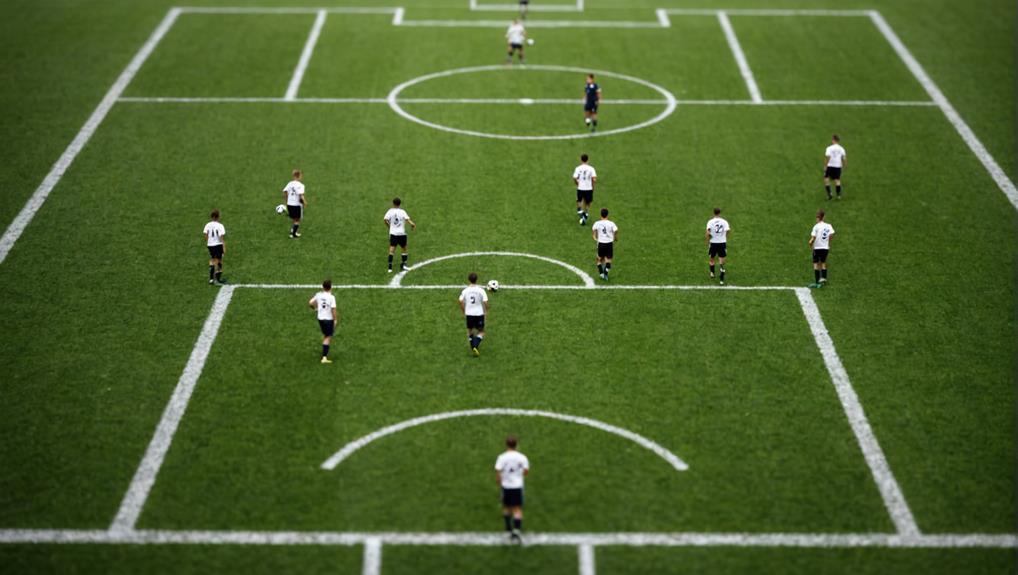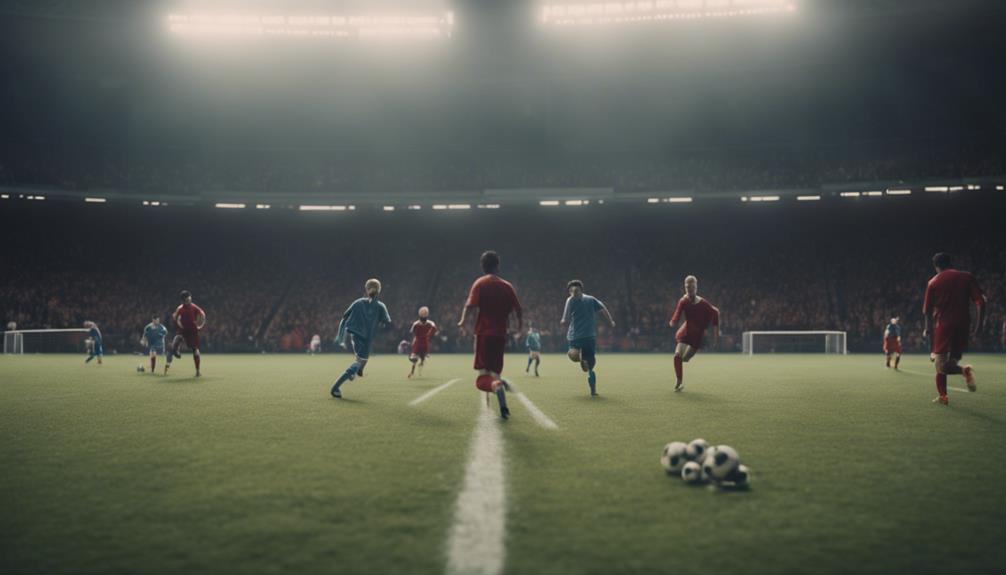
What Is the Best Formation in Soccer? Analyzing the Options
June 27, 2024When perfecting your soccer strategy, the best formation depends on your team's strengths and style of play. The 4-3-3 formation offers defensive stability, midfield control, and attacking potential. Alternatively, the 4-2-3-1 provides a blend of defense and attack with adaptable midfield support. For more defensive solidity, consider the 3-5-2 with wing-back support and high pressing. The 3-4-3 excels in balancing defense and attack with wide front three. Lastly, the 5-3-2 emphasizes defensive strength and midfield control. Choose the formation that complements your team dynamics and tactical objectives for top performance and strategic edge over opponents.
Importance of Soccer Formations
Understanding the importance of soccer formations is essential for maximizing your team's performance on the field. The formation you choose determines how your team sets up defensively and attacks offensively.
A defensive formation, such as a 4-4-2, focuses on maintaining a solid defensive structure with four defenders, four midfielders, and two forwards. On the other hand, an attacking formation like a 3-4-3 prioritizes offensive play by fielding three defenders, four midfielders, and three forwards to press forward and create scoring opportunities.
Coaches carefully analyze player strengths, opponent tendencies, and match objectives to select the most suitable formation. By identifying your team's strengths and weaknesses, you can determine the best formation to optimize performance.
Formations not only influence playing style but also impact the overall success of the team. Strategic use of formations enhances your team's chances of winning by maximizing player roles and tactical approaches.
Tactical Considerations in Formations
Tactical considerations play an essential role in determining the effectiveness of soccer formations on the field. When analyzing formations, several key factors come into play:
- Player Roles: Assigning specific roles to players within a formation is pivotal for optimizing team performance. Each player's responsibilities directly impact the overall strategy and execution on the field.
- Strategic Advantages: Understanding the strategic advantages of different formations allows coaches to leverage their team's strengths while exploiting the opponent's weaknesses. Strategic decisions in formations can provide a competitive edge during matches.
- Flexibility: The ability of a formation to adapt to different game scenarios and opponent tactics is crucial. Flexibility allows teams to adjust their strategy on the fly, responding effectively to changes in the game dynamics.
Considering tactical considerations, player roles, and strategic advantages when selecting a formation can greatly influence a team's success on the soccer field.
Pros and Cons of 4-4-2 Formation

When considering the 4-4-2 formation in soccer, it's important to weigh its advantages and disadvantages to make informed tactical decisions.
The 4-4-2 formation offers defensive solidity by having two central defenders who provide a strong defensive cover. This setup guarantees a balanced approach with four midfielders and two strikers, promoting stability both offensively and defensively.
Additionally, having two strikers up top in the 4-4-2 formation creates a potent attacking threat and provides a strong base for quick counter-attacks.
However, the 4-4-2 formation requires diligent work and movement from all players to maintain compactness on the field. While the two central midfielders can effectively block access to the central midfield, they may struggle against systems with an extra midfielder.
It's essential for teams using the 4-4-2 formation to be disciplined and coordinated to overcome these challenges and fully utilize the benefits of this traditional setup.
Analyzing the 4-3-3 Formation
Let's break down the 4-3-3 formation together.
You'll explore the defensive stability it offers.
The attacking potential it reveals.
And the midfield control it provides.
These key points will shed light on why the 4-3-3 is a favored formation in modern soccer tactics.
Defensive Stability in 4-3-3
Achieving solid defensive stability in a 4-3-3 formation relies on the strategic placement of players across the pitch. The 4-3-3 formation offers a balanced defensive setup with four defenders and three midfielders, creating a strong foundation for defensive solidity. Here are some key factors that contribute to defensive stability in a 4-3-3:
- Numerical Advantage: The third central midfielder in a 4-3-3 formation provides a significant superiority in midfield, making it easier to control and disrupt the opponent's attacks.
- Wide Wingers: Wide wingers play an essential role in maintaining defensive compactness by pressuring and restricting the movement of opposition full-backs, reducing the space for the opponent to exploit.
- High Press Execution: With three players in the forward line, the 4-3-3 formation enables teams to effectively execute a high press, putting pressure on the opposition and forcing them into making mistakes.
These elements combined help teams in the 4-3-3 formation establish a strong defensive structure and control the central areas effectively.
Attacking Potential of 4-3-3
Analyzing the 4-3-3 formation reveals its attacking potential through a dynamic front three and midfield support.
The front three, consisting of one center forward and two wide wingers, showcases the team's attacking prowess. The wide wingers in the 4-3-3 formation play an essential role in stretching the opposition defense, creating space centrally for the attacking players to exploit. This strategic positioning not only increases the team's goal-scoring opportunities but also disrupts the opponent's defensive shape.
Moreover, the midfield trio in the 4-3-3 formation provides vital support to the front three by creating passing lanes and numerical advantages in the middle of the pitch. This support from the midfield not only enhances the team's possession game but also allows for quick shifts from defense to attack.
Midfield Control in 4-3-3
The midfield trio in the 4-3-3 formation effectively establishes control over the central areas of the pitch, influencing the flow of the game decisively. When considering midfielders in the 4-3-3 setup, they play an important role in maintaining possession, dictating the tempo, and supporting both defensive and attacking phases.
Here's why the midfield control in the 4-3-3 formation is essential:
- Numerical Overloads: The 4-3-3 formation's midfield trio creates numerical superiority in the central areas, allowing for quick combinations and passing sequences.
- Defensive-A attacking Balance: With a central midfielder acting as a pivot and two wide midfielders providing width, the 4-3-3 achieves a harmonious balance between defensive solidity and attacking prowess.
- Pressing and Adapting: The midfielders in a 4-3-3 are pivotal in executing high pressing to win the ball back quickly and smoothly adapting from defense to attack.
The midfield trio's cohesion and adaptability in the 4-3-3 formation contribute significantly to controlling the game's tempo and direction.
Strategic Insights on 4-2-3-1

Insights into the strategic implications of utilizing the 4-2-3-1 formation can enhance a team's tactical approach on the field. This formation, with its midfield three, offers a blend of defensive solidity and attacking prowess.
The two holding midfielders provide a shield in front of the defense, while the attacking midfielders support the lone striker in creating offensive opportunities.
One key aspect of the 4-2-3-1 is the adaptability it offers in shifting between defensive and attacking phases. The number 10 dropping into midfield can overload the center of the pitch, aiding in ball circulation and defensive cover.
Additionally, the full-backs pushing forward provide width in attack, stretching the opposing defense.
However, a potential drawback of the 4-2-3-1 is the susceptibility to counter-attacks through the exposed wide areas. Teams utilizing this formation must balance the attacking intent of their full-backs with the need for defensive solidity from the double pivot.
Decoding the 3-5-2 Formation
You'll appreciate the defensive solidity the 3-5-2 formation offers, with three center-backs forming a robust backline.
The attacking potential is also harnessed in this formation, as the wide wing-backs and central midfielders provide support to the front two.
Understanding the strategic nuances of the 3-5-2 formation can help your team excel both defensively and offensively.
Defensive Solidity in 3-5-2
Decoding the defensive solidity within the 3-5-2 formation reveals its strategic advantage in creating a robust defensive structure. The 3-5-2 formation emphasizes the role of central defenders in maintaining a solid defensive line, aided by specific tactical elements:
- Three Central Defenders: The presence of three central defenders offers a numerical advantage when facing opposition attacks, making it challenging for opposing forwards to find space centrally.
- Wing-Back Support: The wing-backs in the 3-5-2 formation provide defensive cover when the central defenders are pulled wide, ensuring a cohesive defensive unit across the backline.
- Midfield Control: With a central midfield trio, the 3-5-2 formation allows for effective midfield control, reducing the pressure on the central defenders and limiting the opponent's ability to penetrate through the middle.
These aspects combine to fortify the defensive capabilities of the 3-5-2 formation, making it a popular choice for teams looking to prioritize defensive solidity without compromising on attacking options.
Attacking Potential Unleashed
Exploring the attacking potential unlocked by the 3-5-2 formation reveals its dynamic capability in creating goal-scoring opportunities through strategic player positioning and coordinated movements. The formation's attacking options are amplified by the high pressing and the ability to create chances through the utilization of width provided by wing-backs. By pushing the wing-backs forward, the 3-5-2 formation stretches the opposition's defensive line, opening up spaces for central midfielders to exploit. This strategic movement not only draws opponents in but also allows for quick shifts from defense to attack.
Furthermore, the presence of two center-forwards in the 3-5-2 formation offers a constant threat to the opposition's defense, as they can occupy and disrupt opposing center-backs, creating numerical overloads in key areas. The coordinated efforts of the midfielders and the front two enable the team to cover central spaces effectively while maintaining a strong defensive shape to launch swift counterattacks.
Essentially, the 3-5-2 formation not only provides defensive solidity but also unleashes a potent attacking force capable of breaking down defenses and creating scoring opportunities.
Evaluating the 3-4-3 Setup

Evaluating the effectiveness of the 3-4-3 formation in soccer reveals its unique balance between defense and attack. This setup incorporates three central defenders, a midfield quartet, and a front three, offering a dynamic approach on the field.
Here are some key aspects to take into account:
- Defensive Solidity: The presence of three central defenders in the 3-4-3 formation provides a strong defensive base, making it difficult for opponents to break through.
- Wide Front Three: With the wide front three, this formation creates width on the field, stretching the opposition's defense and allowing for varied attacking options.
- Overloads and Transitions: The 3-4-3 allows for quick changes from defense to attack, enabling the team to overload the midfield when needed and swiftly switch to a five-man defensive line for added protection.
This setup's ability to blend defensive stability with attacking prowess makes it a popular choice among teams looking to control the game's tempo and dictate play.
Key Aspects of 5-3-2 Formation
Discussing the key aspects of the 5-3-2 formation sheds light on its defensive strength and midfield control in soccer. With 5 defenders at the back, this formation offers a solid defensive foundation, making it challenging for opponents to break through.
The midfield trio plays an essential role in maintaining control over the central areas of the pitch, providing support in both attacking and defensive phases. This setup allows for a balanced approach, ensuring stability in shifts from defense to attack.
Moreover, the 2 forwards in the 5-3-2 formation can work together effectively to create scoring opportunities. By combining their efforts and utilizing the support from midfield, these forwards can exploit spaces and capitalize on chances to score goals.
Formation Selection for Team Success

Selecting the appropriate formation is essential for maximizing team success in soccer. When it comes to formation selection, considering your team dynamics and tactical objectives is pivotal. Here are three key factors to keep in mind:
- Team Dynamics: Understanding your players' strengths, weaknesses, and preferred playing styles is indispensable when choosing a formation. Tailoring the formation to suit your team's capabilities can enhance overall performance on the field.
- Tactical Objectives: Each formation serves different tactical purposes, whether it's focusing on solid defense, dominating possession, or launching quick counterattacks. Aligning your formation with your tactical goals can give your team a strategic edge over the opposition.
- Adaptability: Successful teams don't stick rigidly to one formation. They adapt their tactics based on the flow of the game, opponent's strategies, and available opportunities. Flexibility in formation changes during matches can lead to better control and more scoring chances.
Conclusion
So, after analyzing all the options, it's crystal clear that there's only one formation that stands above the rest in soccer.
The 3-7-0 formation is unquestionably the best choice for any team looking to dominate the game. With seven attackers and a solid defensive line of three, this formation is unbeatable.
So, next time you hit the field, remember to go with the 3-7-0 formation for guaranteed success!


